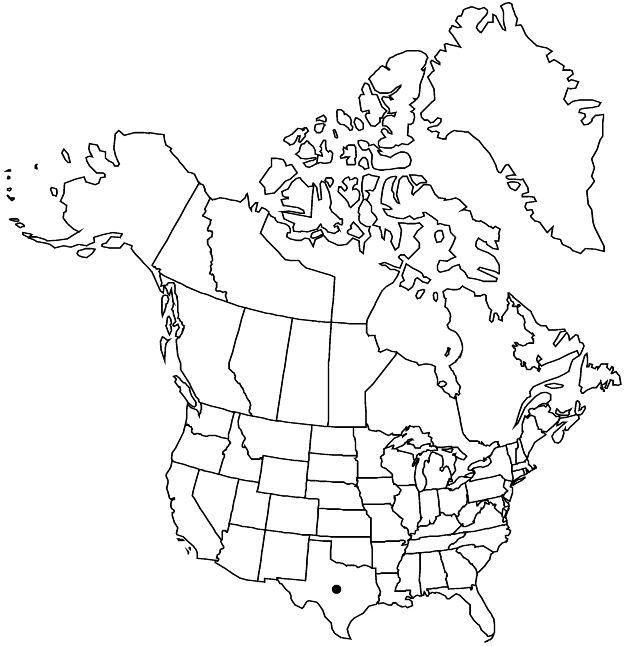Difference between revisions of "Prunus murrayana"
J. Arnold Arbor. 10: 38. 1929.
FNA>Volume Importer |
FNA>Volume Importer |
||
| Line 27: | Line 27: | ||
|elevation=500–1500 m | |elevation=500–1500 m | ||
|distribution=Tex. | |distribution=Tex. | ||
| − | |discussion=<p>Prunus murrayana was long known only from trans-Pecos Texas. M. F. Enquist (1997) expanded the range by recognizing the similarity of these plants to plants from the Edwards Plateau, which he described as a hairy variety of P. rivularis and placed P. murrayana in synonymy. Sequence analysis of DNA from some of the same hairy plants collected by Enquist indicate that these plants are distinct from P. rivularis and are most similar to P. hortulana (J. R. Rohrer et al. 2008). Prunus murrayana is a smaller plant than P. hortulana, with smaller leaves and fruits. Also, P. murrayana suckers to form shrubby thickets; P. hortulana generally forms single trees. The twigs, pedicels, and hypanthium exteriors are hairy in P. murrayana and glabrous in P. hortulana.</p> | + | |discussion=<p><i>Prunus murrayana</i> was long known only from trans-Pecos Texas. M. F. Enquist (1997) expanded the range by recognizing the similarity of these plants to plants from the Edwards Plateau, which he described as a hairy variety of <i>P. rivularis</i> and placed <i>P. murrayana</i> in synonymy. Sequence analysis of DNA from some of the same hairy plants collected by Enquist indicate that these plants are distinct from <i>P. rivularis</i> and are most similar to <i>P. hortulana</i> (J. R. Rohrer et al. 2008). <i>Prunus murrayana</i> is a smaller plant than <i>P. hortulana</i>, with smaller leaves and fruits. Also, <i>P. murrayana</i> suckers to form shrubby thickets; <i>P. hortulana</i> generally forms single trees. The twigs, pedicels, and hypanthium exteriors are hairy in <i>P. murrayana</i> and glabrous in <i>P. hortulana</i>.</p> |
|tables= | |tables= | ||
|references= | |references= | ||
| Line 51: | Line 51: | ||
|publication year=1929 | |publication year=1929 | ||
|special status= | |special status= | ||
| − | |source xml=https://jpend@bitbucket.org/aafc-mbb/fna-data-curation.git/src/ | + | |source xml=https://jpend@bitbucket.org/aafc-mbb/fna-data-curation.git/src/8f726806613d60c220dc4493de13607dd3150896/coarse_grained_fna_xml/V9/V9_638.xml |
|subfamily=Rosaceae subfam. Amygdaloideae | |subfamily=Rosaceae subfam. Amygdaloideae | ||
|tribe=Rosaceae tribe Amygdaleae | |tribe=Rosaceae tribe Amygdaleae | ||
Revision as of 19:18, 18 September 2019
Shrubs, usually suckering, 5–30(–50) dm, ± thorny. Twigs with axillary end buds, hairy. Leaves deciduous; petiole 8–16 mm, usually hairy on both surfaces, sometimes only on adaxial surface, usually glandular distally, glands 1–4; blade lanceolate to elliptic or ovate, usually folded along midribs, 3.5–7.5 × 1.5–3.5 cm, base obtuse to rounded, margins singly to doubly crenate-serrate, teeth blunt, glandular, apex usually acuminate, sometimes acute, abaxial surface glabrous or ± hairy along midribs and veins, adaxial glabrous. Inflorescences 1–4-flowered, umbellate fascicles. Pedicels 4–14 mm, hairy. Flowers blooming at leaf emergence; hypanthium campanulate, 2–2.5 mm, hairy externally; sepals erect to reflexed, ovate, 1.5–2 mm, margins glandular-toothed, abaxial surface glabrate or hairy, adaxial densely hairy at bases; petals white, obovate, 4–8 mm; ovaries glabrous. Drupes red with white dots, slightly to quite glaucous, globose, 10–18 mm, glabrous; mesocarps fleshy; stones ovoid, ± flattened.
Phenology: Flowering Mar–Apr; fruiting Jul–Aug.
Habitat: Rocky stream banks, canyons, dry washes, fence rows
Elevation: 500–1500 m
Discussion
Prunus murrayana was long known only from trans-Pecos Texas. M. F. Enquist (1997) expanded the range by recognizing the similarity of these plants to plants from the Edwards Plateau, which he described as a hairy variety of P. rivularis and placed P. murrayana in synonymy. Sequence analysis of DNA from some of the same hairy plants collected by Enquist indicate that these plants are distinct from P. rivularis and are most similar to P. hortulana (J. R. Rohrer et al. 2008). Prunus murrayana is a smaller plant than P. hortulana, with smaller leaves and fruits. Also, P. murrayana suckers to form shrubby thickets; P. hortulana generally forms single trees. The twigs, pedicels, and hypanthium exteriors are hairy in P. murrayana and glabrous in P. hortulana.
Selected References
None.
